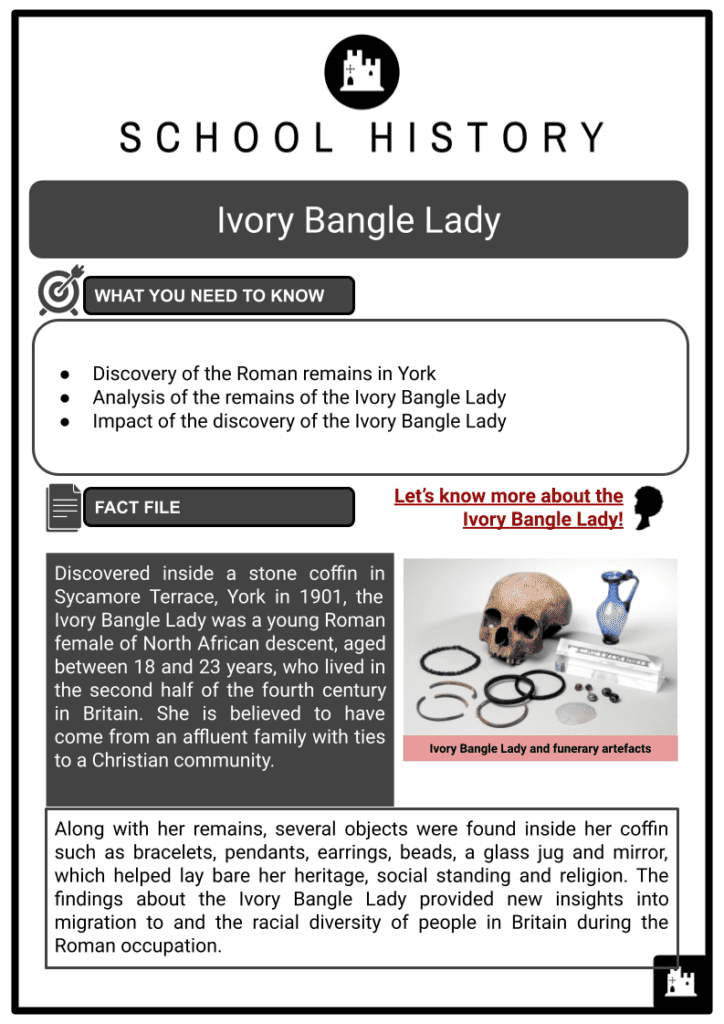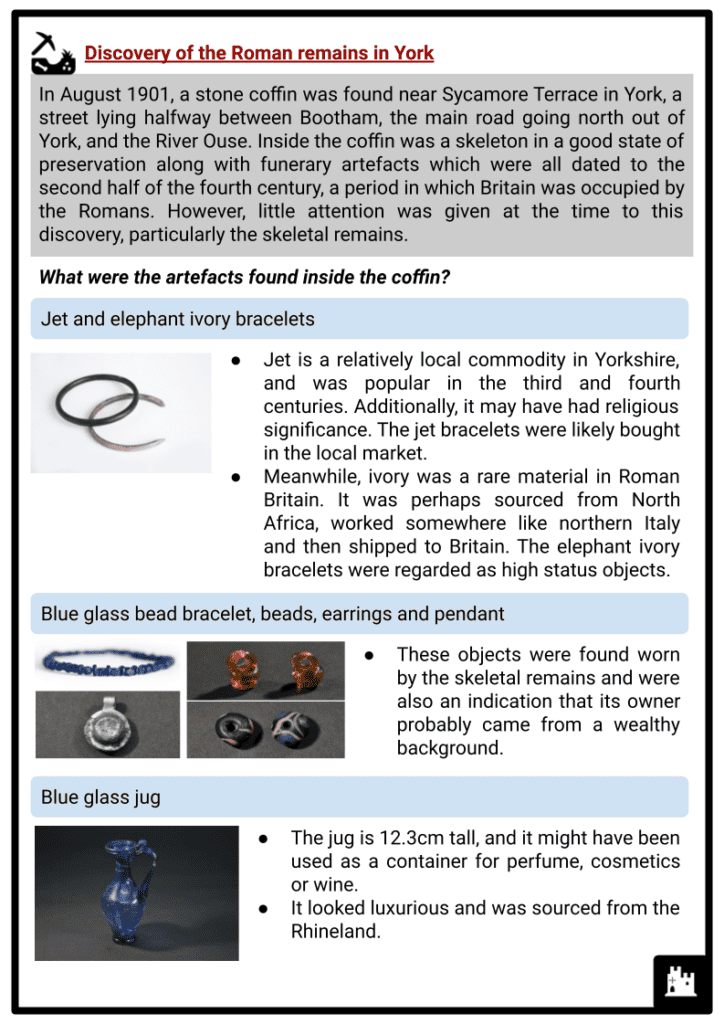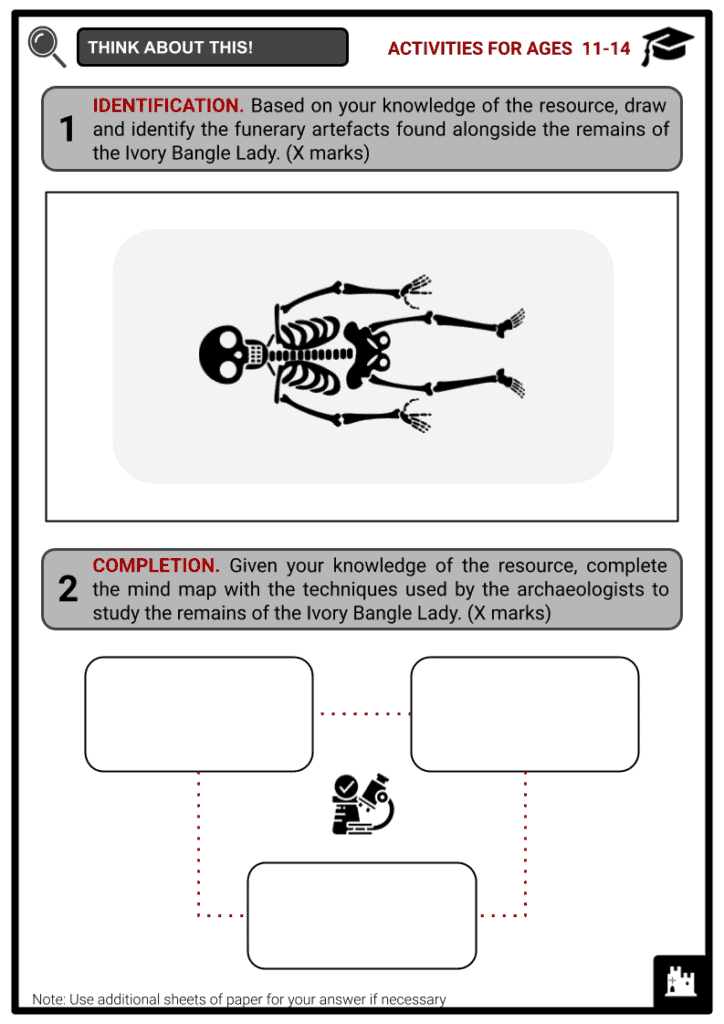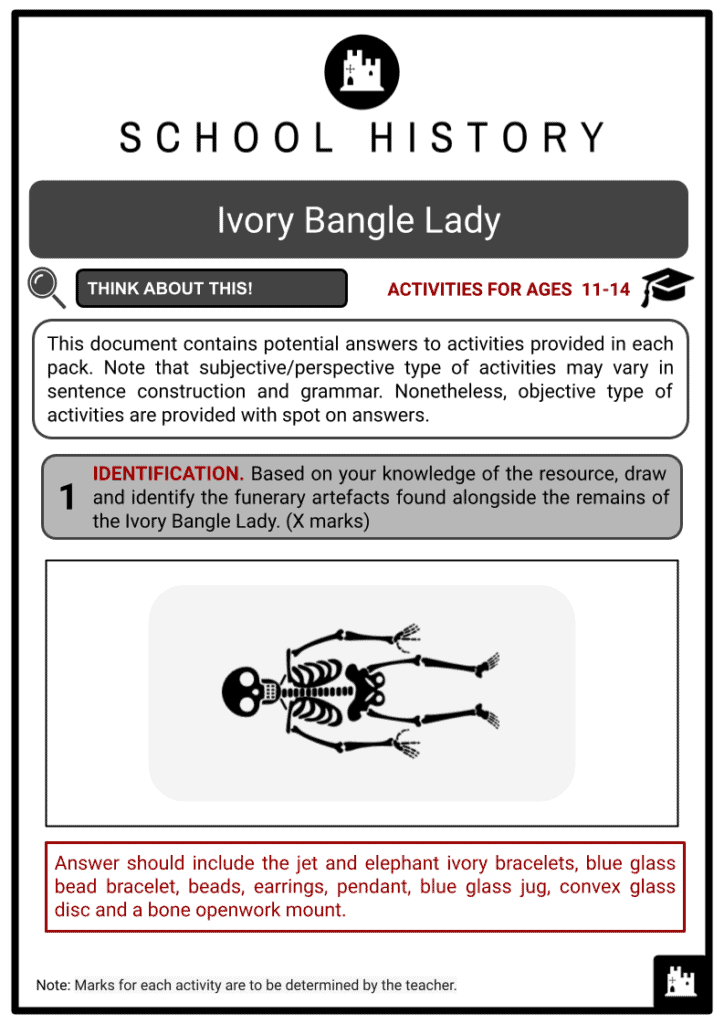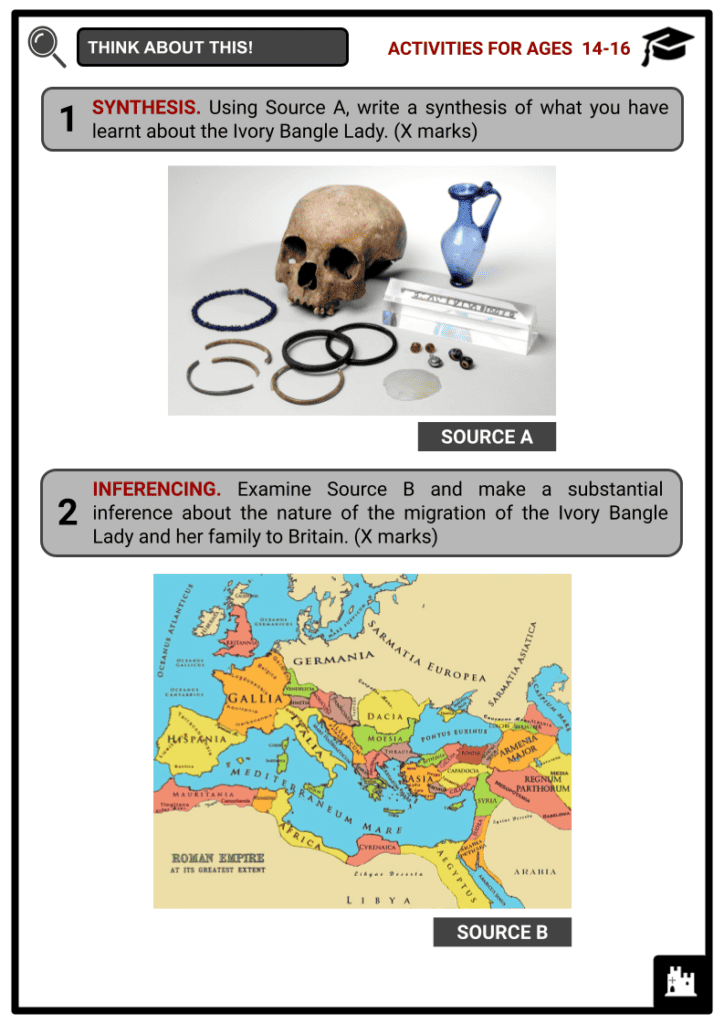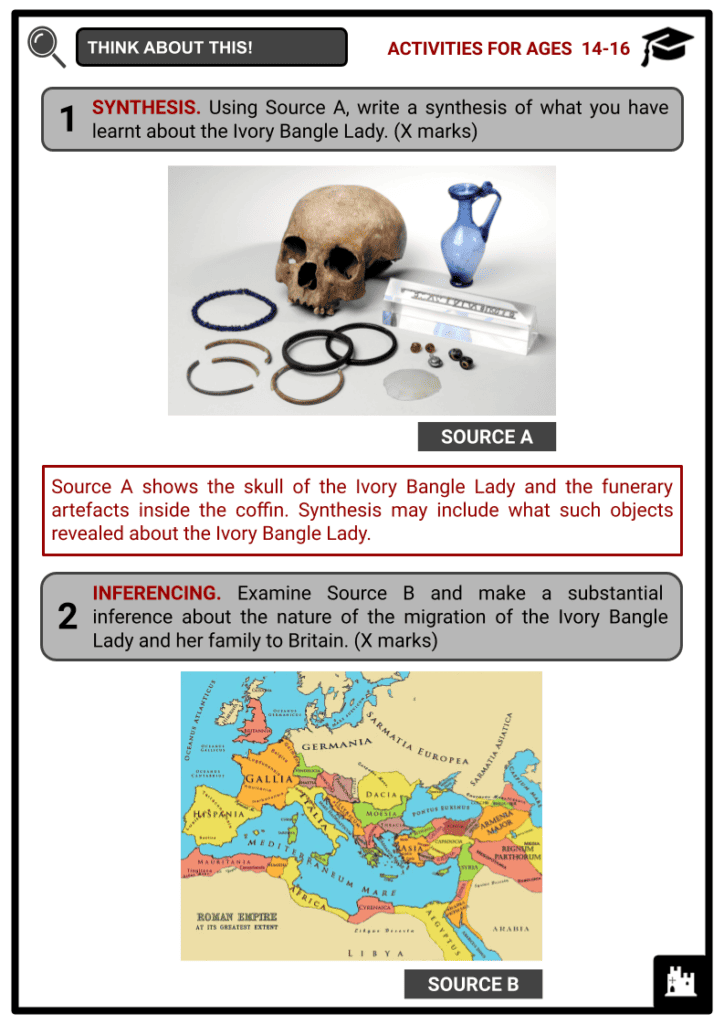Ivory Bangle Lady Worksheets
Do you want to save dozens of hours in time? Get your evenings and weekends back? Be able to teach about the Ivory Bangle Lady to your students?
Our worksheet bundle includes a fact file and printable worksheets and student activities. Perfect for both the classroom and homeschooling!
Summary
- Discovery of the Roman remains in York
- Analysis of the remains of the Ivory Bangle Lady
- Impact of the discovery of the Ivory Bangle Lady
Key Facts And Information
Let’s know more about the Ivory Bangle Lady!
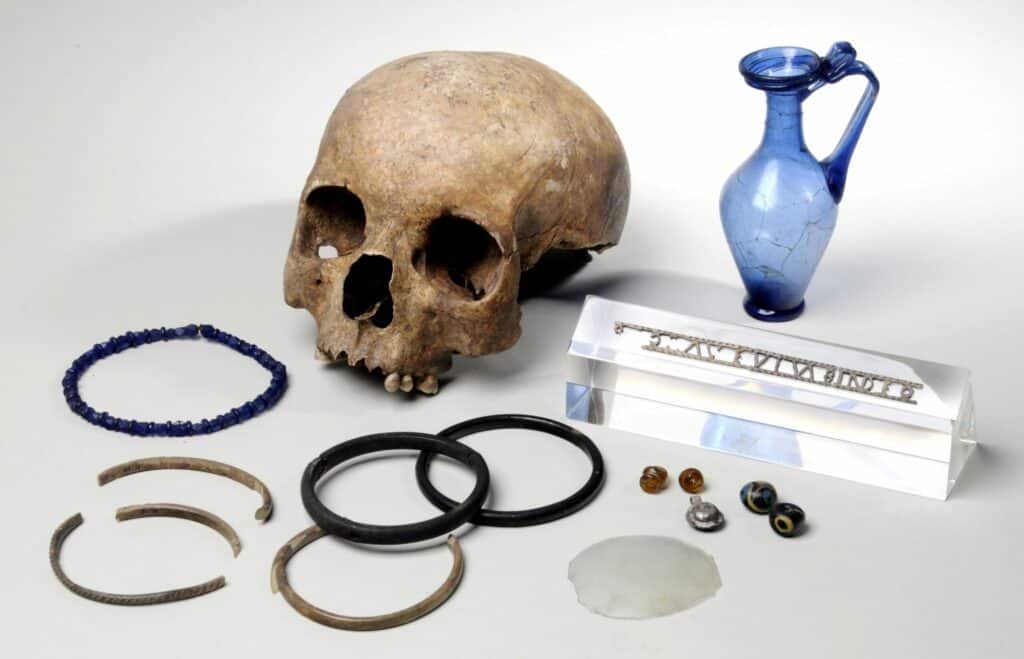
Discovered inside a stone coffin in Sycamore Terrace, York in 1901, the Ivory Bangle Lady was a young Roman female of North African descent, aged between 18 and 23 years, who lived in the second half of the fourth century in Britain. She is believed to have come from an affluent family with ties to a Christian community. Along with her remains, several objects were found inside her coffin such as bracelets, pendants, earrings, beads, a glass jug and mirror, which helped lay bare her heritage, social standing and religion. The findings about the Ivory Bangle Lady provided new insights into migration to and the racial diversity of people in Britain during the Roman occupation.
Discovery of the Roman remains in York
- In August 1901, a stone coffin was found near Sycamore Terrace in York, a street lying halfway between Bootham, the main road going north out of York, and the River Ouse. Inside the coffin was a skeleton in a good state of preservation along with funerary artefacts which were all dated to the second half of the fourth century, a period in which Britain was occupied by the Romans. However, little attention was given at the time to this discovery, particularly the skeletal remains.
What were the artefacts found inside the coffin?
- Jet and elephant ivory bracelets
- Jet is a relatively local commodity in Yorkshire, and was popular in the third and fourth centuries. Additionally, it may have had religious significance. The jet bracelets were likely bought in the local market.
- Meanwhile, ivory was a rare material in Roman Britain. It was perhaps sourced from North Africa, worked somewhere like northern Italy and then shipped to Britain. The elephant ivory bracelets were regarded as high status objects.
- Blue glass bead bracelet, beads, earrings and pendant
- These objects were found worn by the skeletal remains and were also an indication that its owner probably came from a wealthy background.
- Blue glass jug
- The jug is 12.3cm tall, and it might have been used as a container for perfume, cosmetics or wine.
- It looked luxurious and was sourced from the Rhineland.
- Convex glass disc
- This object may have been used as a mirror and was probably polished to give a reflection. It probably had a leather or wooden case that did not survive.
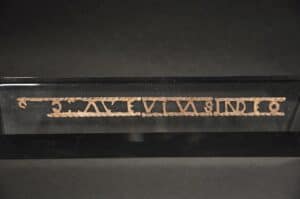
- This object may have been used as a mirror and was probably polished to give a reflection. It probably had a leather or wooden case that did not survive.
- A bone openwork mount
- This was the most famous artefact found inside the coffin.
- It possibly came from an unrecorded wooden casket.
- It reads SOROR AVE VIVAS IN DEO, which translates from Latin to ‘Hail, sister, may you live in God’, reflecting Christian sentiments.
- The skeletal remains and funeral artefacts of what became known as the Ivory Bangle Lady were exhibited together and stored in the Yorkshire Museum.
Analysis of the remains of the Ivory Bangle Lady
- The remains and the accessories of the Ivory Bangle Lady were examined by the Department of Archaeology of the University of Reading. Archaeologists usually employ various techniques in their research and in this case, they included the following:
- Examining the burial rites
- Osteological analysis to find out the ancestry of the remains
- Assessment of the skull shape and chemical signatures preserved in tooth enamel
Studies of the remains of the Ivory Bangle Lady reveal the following:
- A re-assessment of the remains found out that it is of a young female, aged between 18 and 23 years.
- The Ivory Bangle Lady is believed to have been of high status and extreme wealth from Roman York as an assessment of her skeleton did not suggest a strenuous lifestyle.
- The burial and the precious objects found with her both suggested that she was from a wealthy family.
- The osteological analysis disclosed that the facial characteristics of the Ivory Bangle Lady exhibited mixed racial heritage and ancestral links to North Africa.
- The analysis of the chemical elements within her teeth revealed that it is likely that before coming to Roman York, she grew up at the western edge of Britain or an area of similar warm climate on the continent. Moreover, it is also likely that she was brought up in proximity to the coast.
- While the inscription in the bone openwork mount suggests Christian sentiments, this was contrasted by the presence of other funeral artefacts and the alignment of the grave in a north-south arrangement, which strongly implied that the Ivory Bangle Lady was pagan. It is likely that she had links to a Christian community rather than herself being a Christian.
- The research by the University of Reading’s Department of Archaeology pointed to the Ivory Bangle Lady, likely of North African descent, being a high-status incomer to Roman York. Following the publication of the research about the Ivory Bangle Lady and its discussion in the press, her racial identity became the focus of debates and public discussions. Some articles highlighting the Ivory Bangle Lady also received negative comments from alt-right groups.
Impact of the discovery of the Ivory Bangle Lady
- While the Ivory Bangle Lady herself did not change anything in the present-day world, the findings about her remains reveal a bigger story about the people moving around the Roman Empire. The main impact of the Ivory Bangle Lady comes from how fresh studies on her remains have transformed previous understanding of Roman Britain and the presence of Black people in it.
The first Black people in Roman Britain (43–410 CE)
- At its peak, the Roman Empire was the most powerful political and social structure in Western history.
- Augustus Caesar became the first emperor of Rome, and the Roman Empire lasted until the last Roman emperor, Romulus Augustulus, was toppled by the Germanic King Odoacer in the west.
- Rome had been conquering the Mediterranean Sea for decades before it set its sights northwards across the Alps towards Gaul and then finally across the channel into Britain.
- Britain was first invaded by Caesar in 55/54 BCE and following Claudius’s invasion in 43 CE, part of Britain became a Roman province in name.
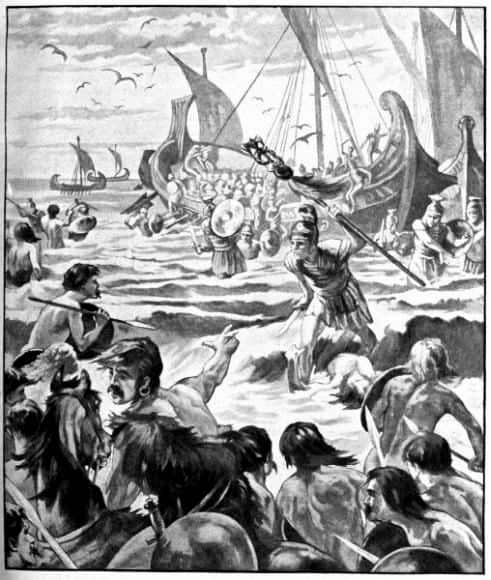
Illustration of the landing of the Romans on the coast of Kent - The Roman conquest of Britain, which proved to be a lengthy process, resulted in the migration of numerous troops and administrators, merchants as well as women and children from many parts of the Empire, including North Africa and Europe.
- In the period that Britain became the Roman Province of Britannia, the total number of people who migrated to the province was not recorded and was hard to estimate.
- By the second and third centuries CE, the first African people arrived in Britain as troops in the Roman armies, who then rebuilt and were stationed along Hadrian’s Wall. In fact, they were under the command of Septimus Severus, a Black Roman Emperor based in York.
- Evidence implies that the populations in major urban and military areas were diverse and locals and incomers were able to intermarry.
- People with African heritage travelled to Britain particularly because of their links to the Roman army. The findings about the Ivory Bangle Lady provided new insights and further proved how racially diverse Roman Yorkshire was. Apart from Septimius Severus, the Ivory Bangle Lady became one of many migrants with African heritage who moved to the city and made it their home. This meant that not only African soldiers but also African people in the upper echelons of society had moved to Britain during the period. Additionally, this also indicates that although slavery existed during the Roman occupation of Britain, people were not enslaved based wholly on their skin colour.

